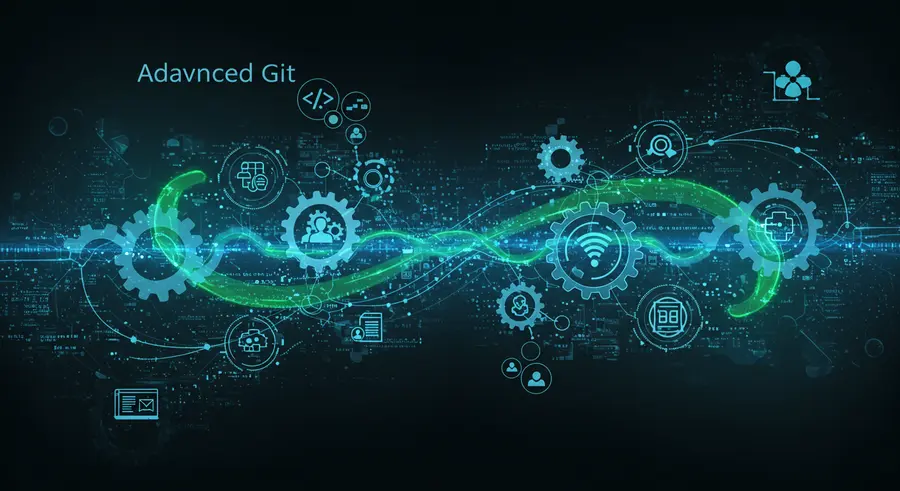Appearance

Welcome, fellow developers! 👋 In today's fast-paced software development world, Git is more than just a version control system; it's the backbone of collaborative success. While basic commit, pull, and push commands get the job done, mastering advanced Git techniques can truly transform your team's efficiency, code quality, and overall development experience.
This article dives deep into sophisticated Git strategies and best practices that empower large teams to work together harmoniously, avoid common pitfalls, and deliver robust software. Let's unlock the full potential of Git!
Why Advanced Git is Crucial for Collaborative Teams 🚀
As teams grow and projects become more complex, the challenges of merging code, resolving conflicts, and maintaining a clean history can quickly escalate. Advanced Git techniques provide the tools to:
- Streamline Workflows: Establish clear, efficient processes for feature development, bug fixing, and releases.
- Enhance Code Quality: Facilitate thorough code reviews and maintain a pristine, understandable commit history.
- Reduce Integration Issues: Minimize merge conflicts and ensure smooth integration of diverse contributions.
- Improve Debugging: Easily trace changes and pinpoint the origin of issues.
- Boost Productivity: Enable developers to work concurrently without stepping on each other's toes.
Key Advanced Git Techniques and Workflows ✨
Let's explore some powerful techniques that every collaborative development team should consider.
1. Branching Strategies: Beyond master/main and develop 🌿
While Git Flow (with master, develop, feature, release, and hotfix branches) has been popular, many modern teams lean towards simpler, more agile approaches like GitHub Flow or Trunk-Based Development.
GitHub Flow:
- A single
mainbranch that is always deployable. - Feature branches are created directly from
main. - Pull Requests (PRs) are central for code review and merging back into
main. - Ideal for continuous delivery environments.
- A single
Trunk-Based Development (TBD):
- Developers commit small, frequent changes directly to a single
mainbranch (the "trunk"). - Feature toggles are used to hide incomplete features.
- Requires strong test automation and disciplined small commits.
- Excellent for high-velocity teams and continuous integration.
- Developers commit small, frequent changes directly to a single
Choosing the Right Strategy: The best strategy depends on your team's size, release cadence, and project complexity. For larger teams, a well-defined branching strategy prevents chaos and ensures a clear path to production.
2. Interactive Rebase (git rebase -i): Cleaning Up History 🧹
Before merging your feature branch, git rebase -i is your best friend for tidying up your commit history. It allows you to:
- Squash Commits: Combine multiple small commits into a single, meaningful one.
- Reorder Commits: Change the order of commits.
- Edit Commits: Modify commit messages or even the changes within a commit.
- Drop Commits: Remove unwanted commits.
When to Use It: Use interactive rebase on your local feature branches before pushing them to a shared remote or creating a Pull Request. Never rebase commits that have already been pushed to a shared branch, as this rewrites history and can cause significant problems for your teammates.
3. Cherry-Picking (git cherry-pick): Selective Changes 🍒
Sometimes, you only need to apply a single commit from one branch to another, without merging the entire branch. git cherry-pick does exactly this.
Use Cases:
- Applying a hotfix from a
hotfixbranch directly tomasterwithout waiting for the nextdevelopmerge. - Backporting a specific feature or bug fix to an older release branch.
4. Git Stash (git stash): A Temporary Holding Area 🎒
You're working on a feature, and suddenly a critical bug needs fixing. You don't want to commit your half-finished work. git stash temporarily saves your uncommitted changes, allowing you to switch branches, fix the bug, and then come back to your original work.
git stash save "message": Stashes your changes with a descriptive message.git stash list: Shows all stashed changes.git stash apply <stash@{n}>: Applies a specific stash without removing it from the stash list.git stash pop <stash@{n}>: Applies a specific stash and removes it from the stash list.
5. Reflog (git reflog): Your Safety Net ⛑️
Ever accidentally deleted a branch, rebased incorrectly, or lost commits? git reflog is your command-line undo button. It records almost every change made to your repository's HEAD.
You can use git reflog to find the SHA-1 hash of a lost commit or state, and then use git cherry-pick or git reset to recover your work.
6. Git Hooks: Automating Workflows 🎣
Git hooks are scripts that Git executes before or after events like committing, pushing, or receiving commits. They allow you to automate tasks and enforce policies.
Common Use Cases:
pre-commit: Run linters, formatters (like ESLint, Prettier), or tests before a commit is created.pre-push: Run comprehensive tests before pushing to a remote repository.post-receive(server-side): Trigger CI/CD pipelines after a push.
Collaborative Best Practices for Large Teams 🤝
Beyond individual techniques, establishing clear team-wide practices is vital:
- Meaningful Commit Messages: Follow conventions (e.g., Conventional Commits) to make history readable and enable automated changelog generation.
- Small, Atomic Commits: Each commit should represent a single, logical change. This makes code reviews easier and simplifies reverting or cherry-picking.
- Frequent Pushes: Push your local branches to the remote frequently. This acts as a backup and allows teammates to see your progress (even on feature branches).
- Regular Pulls/Fetches: Keep your local repository updated with changes from the remote to minimize merge conflicts.
- Code Review Culture: Leverage Pull Requests (or Merge Requests) for thorough code reviews. Tools like GitHub, GitLab, and Bitbucket provide excellent platforms for this.
- Automated Testing & CI/CD: Integrate automated tests and continuous integration/continuous deployment (CI/CD) pipelines to ensure code quality and rapid delivery.
- Documentation: Document your team's chosen Git workflow and best practices.
Learn More and Get Started! 📚
Git's power lies in its flexibility. By understanding and strategically applying these advanced techniques, your team can achieve a higher level of collaboration, maintain cleaner codebases, and deliver software more efficiently.
For more insights into optimizing your software development processes, explore our Software Engineering catalogue page!
Happy Gitting! 💻✨